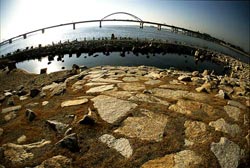When the Japanese archipelago was formed in ancient times, the area that later would become Nishiyodogawa Ward was still under the sea, and the present Osaka Bay was covered with water stretching to the present foot of Mt. Ikoma in the east and present foot of Mt. Rokko in the west. For a long period of time, however, the Yodo River, Yamato River, Muko River, and other rivers continued carrying earth and sand to their estuaries, where sandbanks formed and subsequently developed into islands. In the past, these islands were called "Naniwa Yasojima." It can be said that this history explains why the names of many places in Nishiyodogawa Ward contain "shima or jima (both meaning "island")," such as Utajima, Takejima, Dekijima, Nakajima, Nishijima, Himejima, Hyakushima, and Mitejima. (There used to be areas called Torishima, Sotojima, Minamijima, Kashima, and Kabashima, though today their names have changed.) In these areas, there are many monuments inscribed with poems, indicating that the areas were renowned among the aristocracy, writers and artists in the capital of those days.
However, located near the water, these areas suffered flooding many times in the past. Presently, the deities of Sumiyoshi Shrine, who are worshipped as guardians of the sea, are enshrined in many Shinto shrines in the ward. This might be related to the past experience of recurring floods.
Today, Nishiyodogawa Ward boasts a very strong flood defense organization that has never been seen in other places, which shows that residents in the ward are always aware of the importance of flooding measures. Moreover, as part of such flooding measures, a large-scale tide embankment has been constructed. Furthermore, the construction of "Yodo-no-dai-hosuiro" (a large-scale flood control channel in Yodo) has been launched as a drastic flooding countermeasure.
On April 1, 1925, Nishiyodogawa Ward was born. Through the Meiji, Taisho and early Showa periods (from the end of 19th Century to the beginning of 20th Century), along with rapid construction of railroads, roads and bridges, modern industries such as cotton mills, machinery, metal working, steel and chemical plants began to accumulate and the ward took on the character of a major industrial zone. However, on the negative side these industries became the source of air contamination and gave rise to a serious pollution problem in the ward, but Osaka City promptly took measures to deal with the source of problem with a certain amount of success. In addition, the Ono River and Nakajima Daisuido (spillway), which were once badly polluted, have now been changed into streets with the shade of trees, in order to improve the environment for the life of citizens. The areas are now widely used for people to relax themselves and improve their health.
Ward arterial roads include the major roads: Highway 2, Highway 43 and Yodogawa Dori, the Hanshin Expressway for Ikeda and Kobe and the Bay Line. The railway network includes the Hanshin Main Line/Nishi-Osaka Line, and JR Kobe Line. In 1997, the JR Tozai Line, which was long awaited by residents, was added to the network. The Hanshin Nishi-Osaka Line was extended to Namba, and in March 2009, this line made a new start as the Hanshin Namba Line.
When we invited submission of designs for the mascot for Nishiyodogawa Ward from January 15 to March 15 in 2010, we received a total of 706 design works and decided on one, a motif of the ward flower sazanka (Camellia sasanqua) at the selection committee. We believe that this cute, friendly mascot will be cherished by all generations from adults to children for many years to come.
Subsequently, we invited suggestions for the name of the mascot from May 15 to June 15 in 2010, we received as many as 1,751 names, and the mascot was named "Ni-yon."
As a PR ambassador to Nishiyodogawa Ward, Ni-yon will communicate the attractiveness of Nishiyodogawa Ward to as many people as possible, and actively participate in ceremonies and events.
|


Sazanka (Camellia sasanqua)
| The sazanka (camellia) was selected as the ward flower with the wish that, like the camellia, Nishiyodogawa Ward would develop into a pleasant smelling area. |
| Area |
14.23 |
km2 |
| Population (total) |
96,700 |
persons |
| Male |
47,835 |
persons |
| Female |
48,865 |
persons |
| No. of households |
44,001 |
households |
| Population density |
6,796 |
persons/km2 |
| No. of registered foreigners |
3,081 |
persons |
| (Estimates as of January 1, 2014)
|

|

